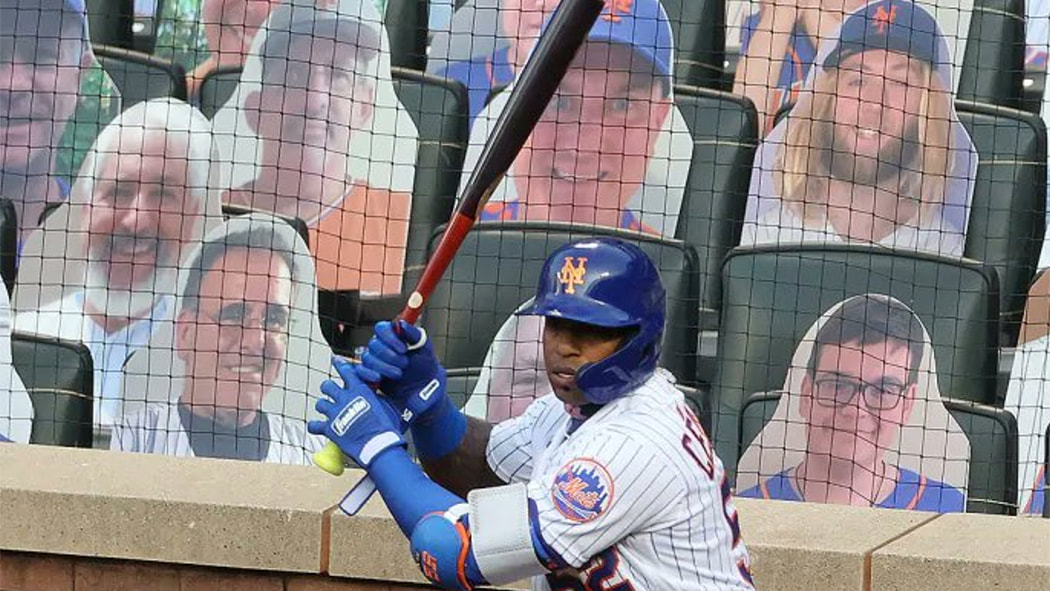|
This is how bad it got bad at the Mets’ home opener on Friday:
When Edwin Diaz walked into the game, the cardboard mockups of real fans began to head for the exits. I swear. Edwin Diaz! Aaagh! Not him again! Cardboard people began checking with the baby-sitter on their phones, began edging toward the rest rooms, began filing out toward the parking lots and the No. 7 elevated train – to get the hell out of there before Diaz torched the place, again. Eight innings into the first game of this bizarre season -- a season I am not sure should exist, given the pandemic -- I experienced the mini-terror of the fan – with no ticking clock, with three massive last outs to achieve. This is the same Edwin Diaz who was acquired by the Mets last year and had one of the worst years ever for a so-called relief pitcher. Fans groaned when they saw him flexing in the bullpen. On Friday, as rigid and lifeless as the fans appeared, they knew a terrifying situation when they saw it. It was a classic Mets’ game of recent seasons, Before Covid. Jacob deGrom pitched five crisp innings, looking like the two-time Cy Young Award winner that he is, reaching his pitch limit, and turning the game over to the bullpen. All those vividly-colored one-inch-thick fans recognized the script – the paralysis of the Mets’ hitters whenever DeGrom pitches. This opener had a subplot – the presence of Freddie Freeman for the Braves, after a terrifying siege with Covid months ago, when he admittedly felt he would not live. Later, he recounted his experience to Nick Markakis, a teammate, who promptly decided to sit out this season. Freeman is back, one of those admirable opponents that even some Mets fans, in all their bilious loyalty, can respect. He monitored first base, and seemed to greet the Mets’ Brandon Nimmo with a tap of his glove after both of Nimmo’s singles. This camaraderie would not have gone over back in the day, when an opponent would have fallen to the ground and called for the umpire to eject Freeman for menacing with his microbe-laden glove. In these nicer times, it was good to see Freeman’s hawk-like features back on the field. The Mets got a post-deGrom run when Yoenis Céspedes clubbed a massive home run, and Diaz induced terror in Mets fans by striding onto the field, but somehow he procured three outs, around a walk (to Freeman), to secure a 1-0 victory, and the Mets remained undefeated 24 days into July. This patchwork “season” may or may not last 60 games. But on Opening Day, with thousands of faux fans planted in the seats, a pyromaniac “relief” pitcher terrified the fans, in whatever form. I know it is hypocritical of me to worry about spreading the virus -- (the Mets abandoned all pretense of safety when they greeted Cespedes in the dugout)-- but baseball, in this strange form, is back. 7/25/2020 09:25:34 am
Geez, George. I didn't see the end of the game and did not know Diaz had gotten the call to finish it up. You had me thinking he had all but blown the win/save. But no! He looked good. All's well. I saw the clip (below). Notwithstanding COVID and these weird times we live in...baseball is back and everything's gonna be all right. Allow me this brief flight from reality. Cheers.
George Vecsey
7/25/2020 10:22:52 pm
Peter: He was back in form Saturday, giving up a ninth-inning, game-tying home run. The Mets' broadcasters made the point that a manager cannot afford patience in a 60-game sprint of a season. (And what a blessing to have good old Gary, Keith and Ron making those knowing points rather than the network foofs who are always just passing through.)
Tom Schwarz
7/25/2020 10:11:36 am
Those poor Cardboardians
George Vecsey
7/25/2020 10:25:47 pm
Tom: I think I am obsessed with those cutouts. The likeness of Jeff McNeil's dog, Willow, was hit by a Met home-run ball today in the RF stands. Willow finished the game. Good girl, Willow! 7/25/2020 01:58:50 pm
I follow all the logic of why it is crazy for any professional athlete, or those playing in college, high school, Little League, Babe Ruth , pick-up games, etc., but I admire their efforts to retain some normalcy.
George Vecsey
7/25/2020 10:30:54 pm
Alan, I get your point. The reasons artists paint all night (I am married to one), and scientists work in the lab to come up with a vaccine, and journalists make that last phone call late in the evening. Many people are driven. But when health is threatened -- when the foe is lethal -- I think "society" needs to look out for people pushing it. I'm an abolitionist about boxing (although I love writing about boxers.) My grand-daughter and her teammates were told, "You can't play soccer this fall for the school." That's looking out for people.Those young women would have played, if possible. You see the swarms in the dugout when somebody hits a home run, Distancing means distancing. Best, GV Comments are closed.
|
Categories
All
|










